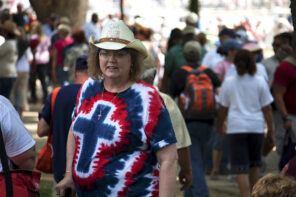The developing data on the religiously unaffiliated and their political leanings is certainly important, and Katherine Stewart is right to raise questions about why this has been ignored by the mainstream media and political organizations (though not here on RD).
However, her push to characterize the unaffiliated as “unbelievers” and “atheists” is refuted by the data to which she refers. By far, as the recent Pew report and other studies have shown, so-called “Nones” are believers in God or a higher power (68%), see themselves as religious or spiritual (65%), see religion as having important social value (69%) despite what they see as an excessive focus on power, rules, and politics (68%). Nearly half (41%) pray at least weekly.
So, as it turns out, unbelievers are not, in fact “a large portion of the unaffiliated,” suffering anti-anti-religious persecution. They are largely theistic in belief, and relatively traditional, if eclectic and inconsistent, in religious or spiritual practice. To paint Nones as a growing European-style secular/atheist population is to misread the available data.
Perhaps a more compelling reason that interest in the political (and other) leanings of Nones has not attracted wider attention is tucked into the preface to the Pew report, which many data-hungry readers are likely to have skipped on their way to colorful charts and graphs:
Scholars of religion in the United States have been using the term “nones” since the 1960s, despite some qualms about its connotations. The term refers to people who answer a survey question about their religion by saying they have no religion, no particular religion, no religious preference, or the like. As sociologist Glenn Vernon of the University of Utah wrote in the Journal for the Scientific Study of Religion in 1968, “It provides a negative definition, specifying what a phenomenon is not, rather than what it is. Intentionally or not, such a use implies that only those affiliated with a formal group are religious.” (p. 7)
Pew researchers attempted to sidestep the difficulties of the term “Nones,” as I noted here, by preferring the term “religiously unaffiliated.” But that hardly solves the problem in that the religiously unaffiliated are also demographically and politically unaffiliated as well. That is, the term “religiously unaffiliated,” like the more popular term “nones,” describes a sociological category that can be studied across many demographic dimensions (age, gender, political orientation, etc.), but which, unlike the Buddhists, Catholics, Jews, Mormons, Presbyterians and so on that fall into the “religiously affiliated” category, otherwise have no institutionalized affinity. Their very unaffiliated status, and the diversity of world views and spiritual outlooks that characterizes that status, makes it impossible for Nones to advocate as a bloc, or for political organizations and candidates to pander to them beyond a new acknowledgement of their widely distributed, growing presence in the culture. They don’t have a central meeting house, a website, a leadership function.
The bad news about this—beyond the practical difficulties of understanding this growing population in any real depth—is that Nones are fast becoming a vast tableau for the projected desires and anxieties of those of varying affiliations. For Christians, they are prodigals lost who, with the right music or marketing or hipster ministries, might be reclaimed. For atheists and secularists, they are the long-suppressed doubters and unbelievers who have, until now, been afraid to “come out” in an all too religiously biased world. The irony in all of this, of course, is that Nones have refused affiliation across the spectrum of belief and unbelief. Stewart’s refusal to hear that participates in the very lack of attentiveness to Nones on their own terms that she calls out among political and media organizations.




